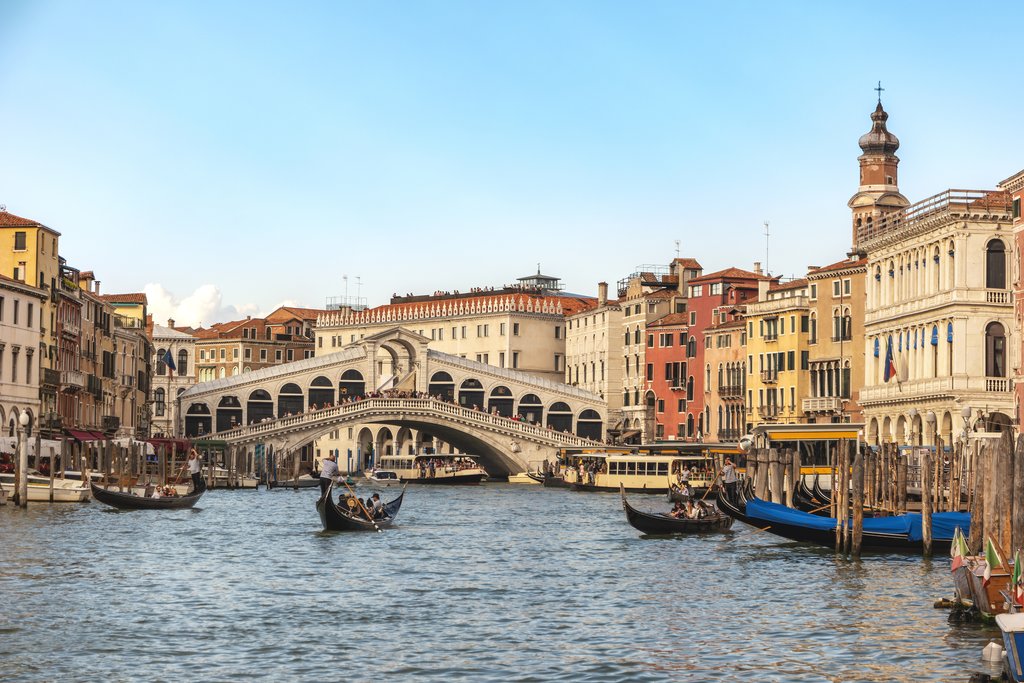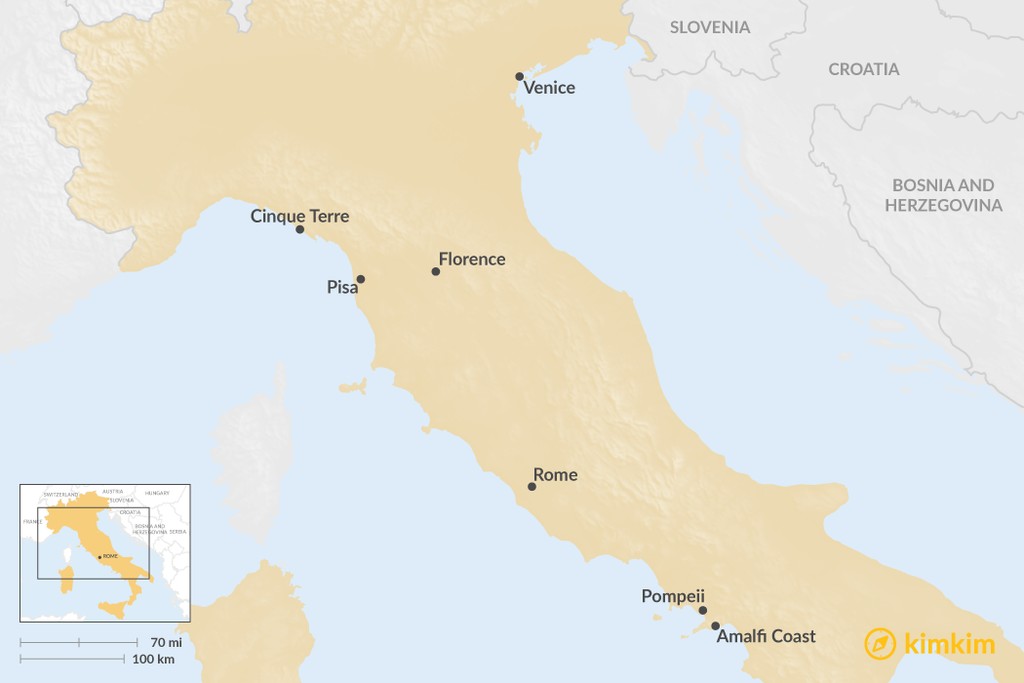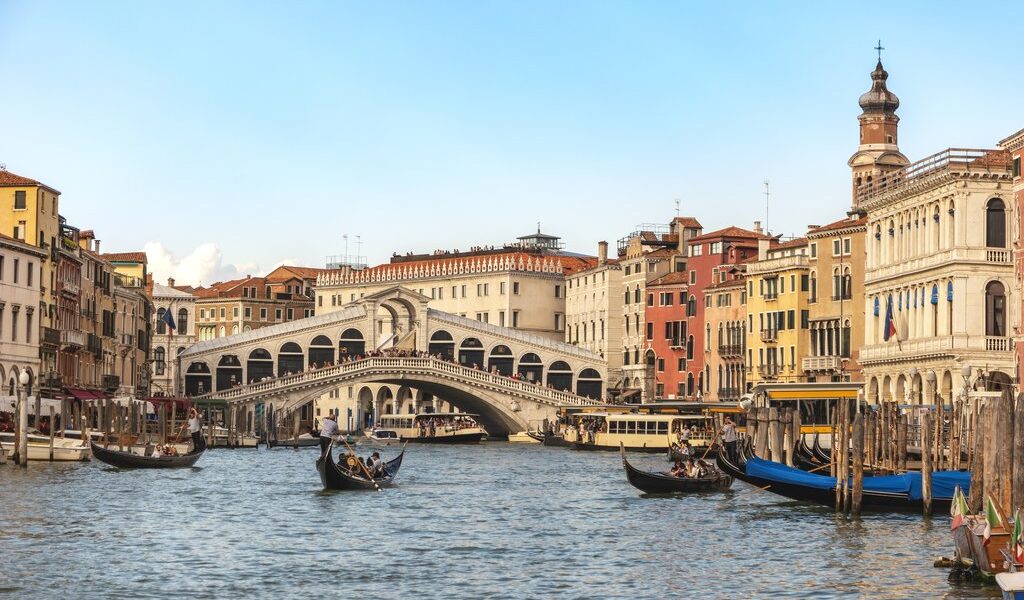
From the cinematic coastline of Amalfi to the canals of Venice, Rome’s lavishly frescoed Sistine Chapel to Florence’s treasure-trove Uffizi Gallery, Italy’s classic stops are worth visiting again and again. Read on for the inside scoop on seven Italian must-sees.
## Pompeii: A Journey Back in Time
Imagine stepping into a world frozen in time, a city brought to a standstill by the wrath of nature. You will never forget the profound moment you first set foot in Pompeii. This once-thriving Roman city, a vibrant hub of commerce and daily life, met its sudden and catastrophic end when the mighty volcanic Mt Vesuvius decided to unleash its fury back in 79 CE. In a devastating display of power, the volcano buried the bustling streets and meticulously crafted homes under a relentless stream of molten lava, suffocating ash, and jagged rock. Now, this remarkable time capsule, a preserved archaeological site of immense historical significance, stands as both a compelling and haunting testament to a bygone era. It’s an experience that transcends time, winging you back almost 2000 years to witness the echoes of Roman civilization.
As you wander through Pompeii, you’ll traverse cobbled lanes, deeply riven with the tracks of countless chariots that once sped through these very streets. These ancient pathways lead to a fascinating array of structures that offer glimpses into the daily life of Pompeii’s inhabitants. Discover the remnants of grand bathhouses, where citizens would gather to socialize and cleanse themselves. Marvel at the intricate frescoes that adorn the walls of luxurious villas, depicting scenes of mythology, nature, and everyday life. Explore the bustling marketplaces, where merchants once hawked their wares, and the impressive amphitheaters, where gladiators engaged in fierce battles to the delight of the crowds. And even venture into a brothel, where you can observe the graffiti of workers and their clients, etched into the walls as a tangible connection to the past.
Unsurprisingly, the allure of Pompeii is undeniable, drawing a substantial number of travelers each year. The destination receives a whopping 2.5 million visitors annually, all eager to witness this extraordinary testament to history. However, the sheer popularity of Pompeii can sometimes lead to overcrowding, particularly during peak season. If you aspire to sidestep those inevitable crowds and gain a more profound and insightful understanding of the ruins, consider joining a guided tour led by knowledgeable experts. These tours often provide the advantage of skipping the long lines, allowing you to enter the site before or after the majority of visitors arrive, ensuring a more intimate and unhurried experience. Additionally, the crowds tend to diminish significantly during the low season, which spans from November through March, offering a quieter and more contemplative atmosphere for exploration. Exploring Pompeii during these months allows for a deeper connection with the site and its history, free from the distractions of large crowds.
## Cinque Terre: A Coastal Paradise
Imagine a place where vibrant colors explode against a backdrop of dramatic cliffs and the azure sea. Cinque Terre, nestled on the breathtaking Ligurian coastline, is a destination unlike any other. Here, houses in candy-bright colors cling tenaciously to cliffs that plunge abruptly into a sea of brilliant blue, creating a spectacle that is both awe-inspiring and captivating. It’s undoubtedly one of the most photogenic places in the whole of Italy, a living postcard that will leave an indelible mark on your memory. The name Cinque Terre translates to “Five Lands,” and it refers to the five charming fishing villages that are perched precariously along this stunning stretch of coastline. These villages, each with its own unique character and allure, are Monterosso, Vernazza, Corniglia, Manarola, and Riomaggiore.
To truly appreciate the beauty and essence of Cinque Terre, it’s essential to venture beyond the confines of a car. The narrow, winding roads that snake along the coastline offer glimpses of the scenery, but they cannot provide the immersive experience that comes from exploring the area on foot. To gain a true sense of the region, you’ll need to embrace the challenge and embark on a hike up and over the cliffs, traversing through the terraced, stone-walled vineyards that define the landscape. This UNESCO World Heritage site is a testament to human ingenuity and the harmonious coexistence of people and nature.
Among the numerous hiking trails that crisscross Cinque Terre, two stand out as particularly noteworthy. The first is the iconic 7.5-mile Sentierro Azzurro (Blue Trail), which connects all five villages and offers breathtaking views of the coastline. This trail is relatively easy to navigate and is suitable for hikers of all skill levels. The second is the more challenging 24-mile Sentiero Rosso, which stretches from Porto Venere to Levanto. This trail offers a more demanding but equally rewarding experience, taking you through rugged terrain and offering panoramic vistas of the surrounding landscape. To access the trails and utilize local transport, the Cinque Terre Card is a valuable investment, providing both convenience and affordability.
For those seeking a deeper immersion into the region’s culture and natural beauty, guided and self-guided walking holidays are an excellent option. These holidays allow you to slip under the skin of Cinque Terre, exploring its hidden corners and discovering its authentic charm. Consider planning your visit during the off-season, when the crowds are thinner and the weather is mild. In fact, you might find it exhilarating to attempt walking between all five villages in a single day, as explored in the fun article about conquering Cinque Terre in February.
## The Enchanting Canals of Venice
Venice, a city of unparalleled beauty and romance, holds a prominent place on every Italy wish list. This unique canal-woven city, adorned with crumbling pastel-colored palazzi, resplendent Renaissance art, mesmerizing masked carnival parades, and the iconic singing gondoliers, embodies the essence of romantic Italy in a nutshell. However, the city’s popularity can lead to overcrowding, especially during the peak summer months (June to September). During this period, Venice is often fit to burst with tourists, making it challenging to fully appreciate its charm and tranquility. Therefore, you might want to consider planning your visit during the shoulder seasons, such as spring or fall, to experience a little more peace and serenity.
Venice becomes infinitely more enjoyable when you resist the urge to relentlessly tick off the blockbuster sights that dominate the tourist itineraries. While iconic landmarks such as the Bridge of Sighs, the Grand Canal, and St Mark’s Square are undoubtedly worth seeing, they often draw massive crowds and detract from the city’s more subtle and authentic charms. The key to getting the best out of Venice is to allow yourself the time to get lost in the less-explored neighborhoods, where you can discover hidden gems and experience the city’s true character.
Venture into neighborhoods such as Cannaregio and its historic Jewish Ghetto, where you can wander through quiet streets, admire the traditional architecture, and soak up the local atmosphere. Alternatively, consider taking a boat to some of the more peaceful islands that dot the Venetian lagoon. Murano, famous for its exquisite glass artistry, offers a fascinating glimpse into the world of glassblowing. Burano, with its brightly colored houses and lacemaking traditions, is a feast for the eyes and a photographer’s dream. And medieval Torcello, with its Venetian-Byzantine cathedral, offers a tranquil escape from the hustle and bustle of the main city.
## The Sistine Chapel: A Masterpiece of Divine Art
Rome’s extravagantly frescoed, overwhelmingly ornate Sistine Chapel stands as the crowning glory of the Vatican, a testament to human artistic achievement and divine inspiration. As you step into this sacred space, you might well gasp out loud when you first cast your eyes upon the breathtaking 800-sq-meter ceiling fresco painted by the incomparable Michelangelo. This tour de force of his artistic genius took him four years to complete, from 1508 to 1512, and it depicts nine vividly rendered scenes from the Book of Genesis. Among these iconic scenes are the creation of Adam and Eve, the Sacrifice of Noah, and the Great Flood, each capturing the drama and majesty of biblical narratives.
Beyond the ceiling, the Sistine Chapel holds even more artistic treasures, including Michelangelo’s Il Giudizio Universale (The Last Judgement). This colossal fresco, which covers the entire altar wall, depicts the second coming of Christ and the final judgment of humanity. The writhing nudes depicted in the fresco caused a scandal when it was completed in 1541, with some subsequently having their modesty ‘covered up’ in an attempt to appease the more conservative elements of society.
To ensure a more enjoyable and less crowded experience, be sure to book your visit in advance. Tour operators can arrange reserved entry, giving you plenty of time to admire Michelangelo’s masterpiece without being jostled by the throngs of tourists.
## The Leaning Tower of Pisa: An Architectural Marvel
Vertically challenged towers don’t get more iconic than this one-of-a-kind landmark in the Tuscan town of Pisa. The Leaning Tower of Pisa, a symbol of architectural eccentricity and human fallibility, has captivated visitors for centuries with its precarious tilt. Go on a busy summer day and you might well be cursing the selfie-sticks and crowds of people trying to prop up the Leaning Tower in their photos. But the tower—and indeed Pisa—merit more than just a quick snapshot. The Leaning Tower of Pisa is an integral part of the architectural ensemble of the Piazza dei Miracoli, a UNESCO World Heritage site that also includes the baptistery and cathedral.
Once a maritime superpower, there is much more to Pisa than the architectural ensemble of the Unesco-listed Piazza dei Miracoli, home to the much-visited tower, the baptistery and cathedral. Go for a wander in the less touristy backstreets and along the banks of the Arno River to see a quieter, more likable side to this medieval city.
And if you’re going to see the off-kilter tower, which took 200 years to (wrongly) build and was completed in 1372, be sure to book ahead or arrange a guided tour. Things quieten down later in the day, and between mid-June and August you can visit after dark.
## The Amalfi Coast: A Coastal Dream
Few can resist the siren call of Amalfi, a swoon-worthy 31-mile stretch of dramatic coastline fringing Italy’s Sorrentine Peninsula in the Campania region. If the craggy peaks, sapphire-blue sea and cliffside villages in a fresco painter’s palette of pastels look like a film set, it’s no coincidence: many movies have been filmed here. Among them is the 2003 romantic comedy Under The Tuscan Sun, where chic Positano plays a starring role.
The Amalfi is beloved of jet-setters and honeymooners, who come to yacht over to islands like Capri, roam romantic villa gardens in Ravello, hang out on the sunny piazzas of Amalfi, and simply kick back and enjoy the endless views of sea and sky.
In summer, it is crowded and extortionately expensive, so you might want to visit in late spring or fall instead. Both are great seasons to come for hiking, for instance on the 7.5-mile Sentiero degli Dei (Path of the Gods), the steep trail between Positano and the low-key fishing village of Praiano. A guided walking holiday gives even greater insight into the area.
## The Uffizi Gallery: A Renaissance Treasure Trove
The artistic brilliance you’ll find in Florence’s magnificent Palazzo degli Uffizi is quite overwhelming. The collection was bequeathed to Florence by the prominent Medici family in 1743 on the condition that it never leave the city.
This is hands-down one of Italy’s foremost art galleries, taking you on a chronological romp from ancient Greek sculpture to Roman art, 13th-century Sienese altarpieces by Giotto, and Venetian masterpieces by Titian. Most of all, the Uffizi is justly celebrated for being the country’s best repository of Renaissance art, with a roll call of greats including Michelangelo, Raphael, Leonardo da Vinci, and a Botticelli, to whom an entire room is devoted.
Snaking lines in summer are to be expected, so make sure you book your tickets and time slot in advance to cut down waiting time. The best option is to hook onto a private tour.
**Word Count: 1769**

B-1377

